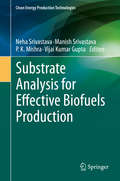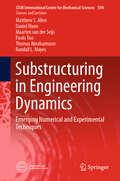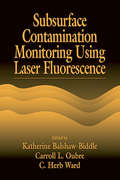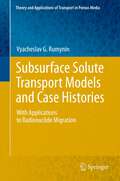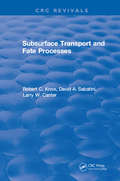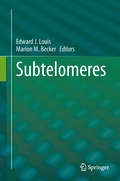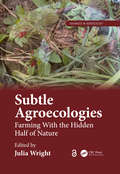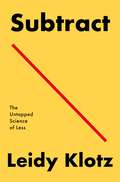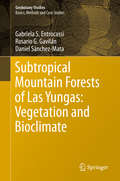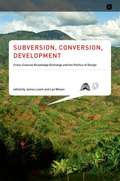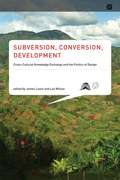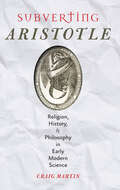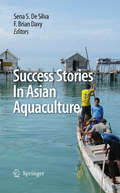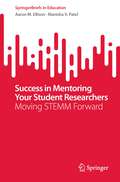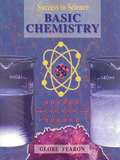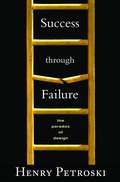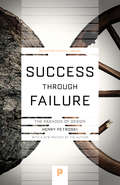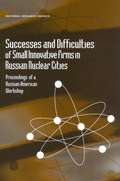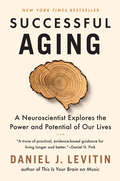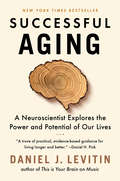- Table View
- List View
Substrate Analysis for Effective Biofuels Production (Clean Energy Production Technologies)
by P. K. Mishra Vijai Kumar Gupta Neha Srivastava Manish SrivastavaAs a substrate, cellulose plays a crucial role in the biomass-based biofuel production process, and is essential to enzyme and sugar production. Accordingly, ensuring maximum availability of cellulose for enzyme production and bioconversion for sugar generation is one of the major challenges for sustainable biofuels production. To date there has been extensive research on biofuel production using lignocellulosic biomass, but there is a huge gap when it comes to the critical analysis of cellulose content, structural feasibility, availability, and economic processing, so that it can be converted for enzyme and fuel production at low cost.Consequently, this book discusses the availability of lignocellulosic substrate for biofuel production in light of the challenges that the biofuels industry is currently facing. After identifying the major substrate selection challenges for the practical biofuel production process, the book addresses said challenges by focusing on various issues such as: potential substrates that have high cellulosic content, structural feasibility, and low-cost & effective processing to remedy the structural complexity of biomass structure and create added value. In addition, it covers recent advancements in cellulase production and outlines future prospects.Given its scope, it offers a valuable guide for research students and industry practitioners alike.
Substructuring in Engineering Dynamics: Emerging Numerical and Experimental Techniques (CISM International Centre for Mechanical Sciences #594)
by Randall L. Mayes Daniel Rixen Matthew S. Allen Maarten van der Seijs Paolo Tiso Thomas AbrahamssonThis book reviews the most common state-of-the art methods for substructuring and model reduction and presents a framework that encompasses most method, highlighting their similarities and differences. For example, popular methods such as Component Mode Synthesis, Hurty/Craig-Bampton, and the Rubin methods, which are popular within finite element software, are reviewed. Similarly, experimental-to-analytical substructuring methods such as impedance/frequency response based substructuring, modal substructuring and the transmission simulator method are presented. The overarching mathematical concepts are reviewed, as well as practical details needed to implement the methods. Various examples are presented to elucidate the methods, ranging from academic examples such as spring-mass systems, which serve to clarify the concepts, to real industrial case studies involving automotive and aerospace structures. The wealth of examples presented reveal both the potential and limitations of the methods.
Subsurface Contamination Monitoring Using Laser Fluorescence (Aatdf Monograph Ser.)
by C. H. Ward Katharine Balshaw-Biddle Carroll L. OubreWhile innovative technologies in remediation need to be developed, so do innovative ways of site assessment. This monograph describes the development, testing, and performance of a new laser-induced fluorescence soil probe. A screening tool for site characterization, this probe has the potential to provide an economical, rapid assessment of contaminated sites.Cone Penetrometer testing equipment advances the probe into the subsurface. The probe identifies hydrocarbon classes using a multi-channel excitation-emission matrix. This technique facilitates the collection of significant amounts of subsurface information - surpassing conventional data collection methods - that can be used to rapidly identify areas of concern beneath a site. The technology has significant application for the following:Rapid environmental site assessmentMonitoring remediation programsMonitoring manufacturing processes and industrial waste water operationsSubsurface Contamination Monitoring Using Laser Fluorescence provides comprehensive reference material for researchers and engineers as well as engineering consultants interested in subsurface monitoring techniques or further development of this technology. It describes innovative technology that focuses on finding cost effective solutions for site assessment and remediation.
Subsurface Solute Transport Models and Case Histories
by Vyacheslav G. RumyninThe book addresses the development of the basic knowledge of the subsurface solute transfer with a particular emphasis on field data collection and analysis coupled with modeling (analytical and numerical) tool application. The relevant theoretical developments are concerned mainly with the formulation and solution of deterministic mass-transport equations for a wide range of engineering issues in groundwater quality assessment and forecasting. The book gives many computational examples and case studies drawn from the conducted field investigations. The analyzed problems are as follows: investigation and prediction of groundwater contamination by industrial contaminants and solutions (radionuclides, chloride and nitrate brine) with special focus on the effect of (a) aquifer heterogeneity, anisotropy, and dual porosity, (b) density contrast existing between industrial waste and groundwater, or in density-stratified artesian and coastal groundwater systems; (c) physicochemical interactions that play a major role in retarding (e.g. adsorption) or enhancing (e.g. interactions between dissolved species and mobile colloids) contaminant transport;prediction of the effects of pumping on groundwater quality at wellfields;groundwater dating using stable and radioactive isotopes for prediction and assessment of contamination potential;field and laboratory tests' design and analysis, and monitoring data interpretation;partitioning of surface and subsurface flows using isotope techniques.One of the most essential topics addressed in the book is the migration and fate of radionuclides. Model development is motivated by field data analysis from a number of radioactively contaminated sites in the Russian Federation: near-surface radioactive waste disposal sites and deep-well radioactive waste injection sites. They play a unique role in the advancement of knowledge of the subsurface behavior and fate of many hazardous radionuclides and can be considered as field-scale laboratories. Thus, the book, along with theoretical findings, contains field information, which will facilitate the understanding of subsurface solute transport and the development of a methodology for practical applications to groundwater hydrology.
Subsurface Transport and Fate Processes
by Robert C. KnoxThis book represents the first comprehensive reference volume available on subsurface transport and fate processes. The volume is organized into four sections covering the basics of contaminant properties and how they affect transport and fate, the fundamental processes affecting subsurface transport and fate of contaminants, applications of transport and fate information to various contaminant types, and utilization of transport and fate information for predicting contaminant behavior. Specific topics such as traditional hydrodynamic processes of advection and dispersion, facilitated transport and contaminant flushing, and individual ground water contaminants are also explored in detail. Subsurface Transport and Fate Processes is ideal for environmental and ground water consultants, regulatory agency personnel, and educators in geology, hydrogeology, civil engineering, and environmental engineering.
Subsurface Upgrading of Heavy Crude Oils and Bitumen
by Cesar OvallesHeavy crude oils and bitumen represent more than 50% of all hydrocarbons available on the planet. These feedstocks have a low amount of distillable material and high level of contaminants that makes their production, transportation, and refining difficult and costly by conventional technologies. Subsurface upgrading of heavy crude oils and bitumen is of interest to the petroleum industry mainly because of the advantages compared to aboveground counterparts. This book presents an “in depth” account and a critical review of the progress of industry and academia in the area of subsurface upgrading of heavy, extra-heavy oils and bitumen, as reported in the patent and open literature.
Subtelomeres
by Edward J. Louis Marion M. BeckerNew genes and diversity leading to adaptation and evolution are generated in special areas of genomes. One such area in all eukaryotic genomes and in those prokaryotes with linear chromosomes is the region near the ends of the chromosomes. These telomere-associated sequences or subtelomeres, have different properties than the rest of the genome and are one of the most exciting frontiers left in genomics. This book provides a broad introduction to the field of subtelomeres with detailed information from various fields and systems, covering yeasts and fungi, pathogens and parasites, plants, insects, humans and primates and bacteria with linear chromosomes. Advances in the field as well as continuing challenges are discussed throughout. The mosaic nature of this collection and the everchanging perspectives reflect the nature of subtelomeres themselves. Unlike the core of most genomes, which are conserved and stable over time, subtelomeres are dynamic and polymorphic, so much so that generally no two individuals look alike in these regions. The dynamic nature of the region and the ability to change the copy number, generate diversity and try novel combinations make it the evolutionary tinker's toolbox. In many organisms the genes found in the region are involved in dealing with the environment. In yeasts, different gene families involved in sugar metabolism as well as clumping together are found in subtelomeres and differences in the region may be the reason why some strains are good for baking, others for brewing and why some are pathogenic. In fungal plant and animal pathogens, many of the genes involved in virulence are found here. In humans and primates there are a number of gene families that vary between ends, for example the diverse olfactory receptor genes. Even in bacterial linear chromosomes the region contains genes involved in adapting to their environments. Perhaps the ultimate use of these regions is in parasites where they rapidly adapt and escape from host immune systems through dynamic changes to the proteins exposed to the host's defenses. Such dynamic, polymorphic structures are also found in plants and insects though it is not always clear what the function might be; in some cases they take on the role of end maintenance. The dynamic, polymorphic nature of subtelomeres, where many ends share segmental duplications, is an exciting area for study but also presents a difficult challenge from the technical perspective.
Subtle Agroecologies: Farming With the Hidden Half of Nature (Advances in Agroecology)
by Julia Wright Nicholas ParrottThis book is about the invisible or subtle nature of food and farming, and also about the nature of existence. Everything that we know (and do not know) about the physical world has a subtle counterpart which has been scarcely considered in modernist farming practice and research. If you think this book isn’t for you, if it appears more important to attend to the pressing physical challenges the world is facing before having the luxury of turning to such subtleties, then think again. For it could be precisely this worldview – the one prioritises the physical-material dimension of reality - that helped get us into this situation in the first place. Perhaps we need a different worldview to get us out? This book makes a foundational contribution to the discipline of Subtle Agroecologies, a nexus of indigenous epistemologies, multidisciplinary advances in wave-based and ethereal studies, and the science of sustainable agriculture. Not a farming system in itself, Subtle Agroecologies superimposes a non-material dimension upon existing, materially-based agroecological farming systems. Bringing together 43 authors from 12 countries and five continents, from the natural and social sciences as well as the arts and humanities, this multi-contributed book introduces the discipline, explaining its relevance and potential contribution to the field of Agroecology. Research into Subtle Agroecologies may be described as the systematic study of the nature of the invisible world as it relates to the practice of agriculture, and to do this through adapting and innovating with research methods, in particular with those of a more embodied nature, with the overall purpose of bringing and maintaining balance and harmony. Such research is an open-minded inquiry, its grounding being the lived experiences of humans working on, and with, the land over several thousand years to the present. By reclaiming and reinterpreting the perennial relationship between humans and nature, the implications would revolutionise agriculture, heralding a new wave of more sustainable farming techniques, changing our whole relationship with nature to one of real collaboration rather than control, and ultimately transforming ourselves.
Subtract: The Untapped Science of Less
by Leidy KlotzBlending evidence across science and design, Subtract: The Untapped Science of Less offers a revolution in problem-solving: proving why we overlook subtraction, and how we can access its true potentialWe pile on “to-dos” but don’t consider “stop-doings.” We create incentives for good behavior, but don’t get rid of obstacles to it. We collect new-and-improved ideas, but don’t prune the outdated ones. Every day, across challenges big and small, we neglect a basic way to make things better: we don’t subtract.Leidy Klotz’s pioneering research shows why. Whether we’re building Lego models or cities, grilled-cheese sandwiches or strategic plans, our minds tend to add before taking away. Even when we do think of it, subtraction can be harder to pull off because an array of biological, cultural, and economic forces push us towards more. But we have a choice—our blind spot need not go on taking its toll on our cities, our institutions, and our minds. By diagnosing our neglect of subtraction, we can treat it. Subtract will change how you change your world. In these pages you’ll meet subtracting exemplars: design geniuses, Nobel Prize-winners, rock-stars, and everyday heroes, who have subtracted to dismantle racism, advance knowledge, heal the planet, and even tell better jokes. These and more guiding lights show how we can revolutionize not just our day-to-day lives, but our collective legacy. A paradigm shift of a book, Subtract shows us how to find more of the options we’ve been missing—and empowers us to pursue them.
Subtropical Mountain Forests of Las Yungas: Vegetation and Bioclimate (Geobotany Studies)
by Gabriela S. Entrocassi Rosario G. Gavilán Daniel Sánchez-MataThe vegetation addressed in this book is, biologically, one of the most diverse on Earth, with many characteristic taxa offering refuge and food sources for many resident and migratory animals. Yet the forests of Las Yungas remain poorly known from a floristic and vegetation point of view. This book seeks to fill that gap by studying the distribution of forest along an altitudinal but also a bioclimatic gradient. The richness in species demonstrates that these forests are substantially more diverse than other subtropical mountain woodlands. 103 diagnostic (characteristic or indicator) species were selected, of which 29 are dominant, 67 are exclusive, selective, preferential or differential, and 7 are stenoic. In addition, 13 communities were identified and characterized. These forests can be attributed to the Bolivian-Tucuman biogeographical province (South-Andean Region, Neotropical Sub-Kingdom). They are seasonal, semi-deciduous or evergreen micro- and mesowoodlands growing on foothills, hillsides, ravines, gorges and the edges of mountain ranges (terrestrial communities), as well as river terraces and beaches (riparian communities). Thanks to the range of new findings, the content presented here will benefit experts in related fields such as geographers, ecologists and botanists, but also teachers, nature guides, those involved in the management of forest or conservation areas, and policymakers.
Suburban Safari
by Hannah HolmesA scientist spends a year in the (suburban) jungle, providing us an intimate look at the critters in our very backyards.
Subversion, Conversion, Development
by James Leach Lee WilsonThis book explores alternative cultural encounters with and around information technologies. These encounters are alternative because they counter dominant, Western-oriented notions of media consumption; they include media practices as forms of cultural resistance and subversion, "DIY cultures," and other nonmainstream models of technology production. The contributors -- leading thinkers in science and technology studies, anthropology, and software design -- pay special attention to the specific inflections that different cultures and communities give to the value of knowledge. The richly detailed accounts presented here challenge the dominant view of knowledge as a neutral good -- information available for representation and encoding but separated from all social relations. The chapters examine specific cases in which the forms of knowledge and cross-cultural encounters are shaping technology use and development. They consider design, use, and reuse of technological tools, including databases, GPS devices, books, and computers, in locations that range from Australia and New Guinea to Germany and the United States. ContributorsPoline Bala, Alan Blackwell, Wade Chambers, Michael Christie, Hildegard Diemberger, Stephen Hugh-Jones, James Leach, Jerome Lewis, Dawn Nafus, Gregers Petersen, Marilyn Strathern, David Turnbull, Helen Verran, Laura Watts, Lee Wilson
Subversion, Conversion, Development
by James Leach Lee WilsonThis book explores alternative cultural encounters with and around information technologies. These encounters are alternative because they counter dominant, Western-oriented notions of media consumption; they include media practices as forms of cultural resistance and subversion, "DIY cultures," and other nonmainstream models of technology production. The contributors -- leading thinkers in science and technology studies, anthropology, and software design -- pay special attention to the specific inflections that different cultures and communities give to the value of knowledge. The richly detailed accounts presented here challenge the dominant view of knowledge as a neutral good -- information available for representation and encoding but separated from all social relations. The chapters examine specific cases in which the forms of knowledge and cross-cultural encounters are shaping technology use and development. They consider design, use, and reuse of technological tools, including databases, GPS devices, books, and computers, in locations that range from Australia and New Guinea to Germany and the United States. ContributorsPoline Bala, Alan Blackwell, Wade Chambers, Michael Christie, Hildegard Diemberger, Stephen Hugh-Jones, James Leach, Jerome Lewis, Dawn Nafus, Gregers Petersen, Marilyn Strathern, David Turnbull, Helen Verran, Laura Watts, Lee Wilson
Subverting Aristotle: Religion, History, and Philosophy in Early Modern Science
by Craig MartinHow new thinking about history, evidence, and scientific authority depended on undermining the authority of Aristotelianism."The belief that Aristotle’s philosophy is incompatible with Christianity is hardly controversial today," writes Craig Martin. Yet "for centuries, Christian culture embraced Aristotelian thought as its own, reconciling his philosophy with theology and church doctrine. The image of Aristotle as source of religious truth withered in the seventeenth century, the same century in which he ceased being an authority for natural philosophy." In this fresh study of the complicated origins of revolutionary science in the age of Bacon, Hobbes, and Boyle, Martin traces one of the most important developments in Western European history: the rise and fall of Aristotelianism from the eleventh to the eighteenth century.Medieval theologians reconciled Aristotelian natural philosophy with Christian dogma in a synthesis that dominated religious thought for centuries. This synthesis unraveled in the seventeenth century contemporaneously with the emergence of the new natural philosophies of the scientific revolution. Important figures of seventeenth-century thought strove to show that the medieval appropriation of Aristotle defied the historical record that pointed to an impious figure of dubious morality. While numerous scholars have written on the seventeenth-century downfall of Aristotelianism, almost all of those works have examined how the conceptual content of the new sciences—such as the heliocentric cosmology, atomism, mechanical and mathematical models, and experimentalism—were used to dismiss the views of Aristotle. Subverting Aristotle is the first to focus on the religious polemics accompanying the scientific controversies that led to the eventual demise of Aristotelian natural philosophy.Martin’s thesis draws extensively on primary source material from England, France, Italy, Germany, and the Netherlands. It alters present perceptions not only of the scientific revolution but also of the role of Renaissance humanism in the forging of modernity.
Success Stories in Asian Aquaculture
by F. Brian Davy Sena S. De SilvaThe stories presented in Success Stories in Asian Aquaculture reflect the unique nature of Asian aquaculture, providing first-time insight into how and why it has become so successful. Overall, the book demonstrates how the resilience, adaptability, and innovation of small-scale aquaculture farmers have been crucial to this success. It also places aquaculture development in Asia into a wider global context, and describes its relationship to natural systems, social conditions, and economics. The book is unique in its in-depth presentation of primary research on Asian aquaculture, and in demonstrating how aquaculture can have a lasting positive impact on livelihoods, food security, and sustainable development. This book will appeal to a wide range of readers. The introduction and conclusion give an excellent general overview of Asian aquaculture, and the individual case studies provide a wealth of new information for specialist readers. Researchers, development workers, and decision-makers, in particular, will be interested in how the Asian experience might be used to strengthen aquaculture development more generally and in other parts of the developing tropics of Latin America and Africa.
Success and Creativity in Scientific Research: Amaze Your Friends and Surprise Yourself
by David S. ShollLong-term success in scientific research requires skills that go well beyond technical prowess. Success and Creativity in Scientific Research: Amaze Your Friends and Surprise Yourself is based on a popular series of lectures the author has given to PhD students, postdoctoral researchers, and faculty at the Georgia Institute of Technology. Both entertaining and thought-provoking, this essential work supports advanced students and early career professionals across a variety of technical disciplines to thrive as successful and innovative researchers. Features: Discusses habits needed to find deep satisfaction in research, systematic and proven methods for generating good ideas, strategies for effective technical writing, and making compelling presentations Uses a conversational tone, making extensive use of anecdotes from scientific luminaries to engage readers Provides actionable methods to help readers achieve long-term career success Offers memorable examples to illustrate general principles Features topics relevant to researchers in all disciplines of science and engineering This book is aimed at students and early career professionals who want to achieve the satisfaction of performing creative and impactful research in any area of science or engineering.
Success and Suppression
by Dag Nikolaus HasseDag Nikolaus Hasse shows how ideological and scientific motives led to the decline of Arabic traditions in European culture. The Renaissance was a turning point: on the one hand, Arabic scientific traditions reached their peak of influence in Europe; on the other, during this period the West began to forget, or suppress, its debt to Arabic culture.
Success in Mentoring Your Student Researchers: Moving STEMM Forward (SpringerBriefs in Education)
by Aaron M. Ellison Manisha V. PatelThis book is a guide for mentors on how to recruit, mentor, and support students through a student research experience in science, technology, engineering, mathematics, and medicine (STEMM) fields. Being a successful research mentor benefits from the self-awareness and planning, strategies and skills that Success in Mentoring your Student Researchers can help you build and develop. These are useful for mentors working with any students, but especially those who have been minoritized in STEMM or are the first in their family to attend college. The first part of the book introduces mentoring undergraduates and how it differs from traditional classroom instruction, active learning, and flipped classrooms; mentoring is collaboratively teaching research while doing research. A mentored undergraduate research experience also helps your mentees develop the skills necessary to be successful scientists and become part of STEMM communities. The central part of the book presents the undergraduate research experience as a “three-legged stool” whose legs—research, education, and community—each have unique values in advancing your mentees’ path in STEMM and all of which require setting, communicating, and realizing expectations for “success”--your mentees’ and your own. The last part of the book looks beyond the research experience, from evaluating your success as a mentor through helping your mentees to continue to develop and grow their STEMM careers and become mentors themselves. This book is the mentor’s companion to the authors’ book for students, “Success in Navigating your Student Research Experience: Moving Forward in STEMM.”
Success in Navigating Your Student Research Experience: Moving Forward in STEMM (SpringerBriefs in Education)
by Aaron M. Ellison Manisha V. PatelThis book is a complete guide for students on how to make the most of intensive, experiential research outside a college classroom. Engaging in research as an undergraduate can lead to successful and rewarding careers in science, technology, engineering, mathematics, and medicine (STEMM). Being successful in an undergraduate research experience benefits from the self-awareness and planning, strategies and skills that Success in Navigating your Student Research Experience can help you build and develop. The first part of this book describes strategies and processes for finding, applying, and preparing for an undergraduate research experience that matches your own needs and interests. These strategies are useful for any student, but are particularly helpful for individuals who have been minoritized in STEMM or are the first in their family to attend college. The central part of the book presents the undergraduate research experience as a “three-legged stool” whose legs—research, education, and community—each have unique values in advancing your path in STEMM. The last part of the book illustrates the many options for continuing and expanding your path in research. These range from communicating results to colleagues to moving forward with graduate studies and careers in STEMM, in which you can become a mentor to the next generation of students.This book is the student’s companion to the authors’ book for mentors, “Success in Mentoring your Student Researchers: Moving STEMM Forward.”
Success in Science: Basic Chemistry
by Globe FearonSuccess in Science: Basic Chemistry provides critical test-preparation strategies for all ability levels. This book helps students reading below grade level develop the science content knowledge they need to succeed in class and on standardized tests.
Success through Failure
by Henry PetroskiDesign pervades our lives. Everything from drafting a PowerPoint presentation to planning a state-of-the-art bridge embodies this universal human activity. But what makes a great design? In this compelling and wide-ranging look at the essence of invention, distinguished engineer and author Henry Petroski argues that, time and again, we have built success on the back of failure--not through easy imitation of success.Success through Failure shows us that making something better--by carefully anticipating and thus averting failure--is what invention and design are all about. Petroski explores the nature of invention and the character of the inventor through an unprecedented range of both everyday and extraordinary examples--illustrated lectures, child-resistant packaging for drugs, national constitutions, medical devices, the world's tallest skyscrapers, long-span bridges, and more. Stressing throughout that there is no surer road to eventual failure than modeling designs solely on past successes, he sheds new light on spectacular failures, from the destruction of the Tacoma Narrows Bridge in 1940 and the space shuttle disasters of recent decades, to the collapse of the World Trade Center in 2001. Petroski also looks at the prehistoric and ancient roots of many modern designs. The historical record, especially as embodied in failures, reveals patterns of human social behavior that have implications for large structures like bridges and vast organizations like NASA. Success through Failure--which will fascinate anyone intrigued by design, including engineers, architects, and designers themselves--concludes by speculating on when we can expect the next major bridge failure to occur, and the kind of bridge most likely to be involved.
Success through Failure: The Paradox of Design (Princeton Science Library)
by Henry PetroskiDesign pervades our lives. Everything from drafting a PowerPoint presentation to planning a state-of-the-art bridge embodies this universal human activity. But what makes a great design? In this compelling and wide-ranging look at the essence of invention, distinguished engineer and author Henry Petroski argues that, time and again, we have built success on the back of failure--not through easy imitation of success. Success through Failure shows us that making something better--by carefully anticipating and thus averting failure--is what invention and design are all about. Petroski explores the nature of invention and the character of the inventor through an unprecedented range of both everyday and extraordinary examples--illustrated lectures, child-resistant packaging for drugs, national constitutions, medical devices, the world's tallest skyscrapers, long-span bridges, and more. Stressing throughout that there is no surer road to eventual failure than modeling designs solely on past successes, he sheds new light on spectacular failures, from the destruction of the Tacoma Narrows Bridge in 1940 and the space shuttle disasters of recent decades, to the collapse of the World Trade Center in 2001. Petroski also looks at the prehistoric and ancient roots of many modern designs. The historical record, especially as embodied in failures, reveals patterns of human social behavior that have implications for large structures like bridges and vast organizations like NASA. Success through Failure--which will fascinate anyone intrigued by design, including engineers, architects, and designers themselves--concludes by speculating on when we can expect the next major bridge failure to occur, and the kind of bridge most likely to be involved.
Successes and Difficulties of Small Innovative Firms in Russian Nuclear Cities: Proceedings of a Russian-American Workshop
by Committee on Small Innovative Firms in Russian Nuclear CitiesThis workshop report focuses on successes and failures of small innovative firms in five science cities in Russia. The workshop was organized by the NRC with the cooperation of Minatom.
Successful Aging: A Neuroscientist Explores the Power and Potential of Our Lives
by Daniel LevitinAuthor of the iconic bestsellers This Is Your Brain on Music and The Organized Mind, Daniel Levitin turns his keen insights to what happens in our brains as we age; why we should think about health span, not life span; and, based on a rigorous analysis of neuroscientific evidence, how you can make the most of your seventies, eighties, and nineties today, no matter how old you are now. <P><P>Successful Aging uses research from developmental neuroscience and the psychology of individual differences to show that sixty-plus years is a unique developmental stage that, like infancy or adolescence, has its own demands and distinct advantages. Levitin looks at the science behind what we can all learn from those who age joyously, as well as how to adapt our culture to take full advantage of older people's wisdom and experience. Throughout his exploration of what aging really means, Levitin reveals resilience strategies and practical, cognitive enhancing tricks everyone can do as they age. <P><P>This book is packed with accessible and discussable takeaways, providing great material for reading groups and media coverage. <P><P>Successful Aging inspires a powerful new approach to how readers think about our final decades, and it will revolutionize the way we plan for old age as individuals, family members, and citizens within a society where the average life expectancy continues to rise. <P><P><b>A New York Times Bestseller</b>
Successful Aging: A Neuroscientist Explores the Power and Potential of Our Lives
by Daniel LevitinAuthor of the iconic bestsellers This Is Your Brain on Music and The Organized Mind, Daniel Levitin turns his keen insights to what happens in our brains as we age, why we should think about health span, not life span, and, based on a rigorous analysis of neuroscientific evidence, what you can do to make the most of your seventies, eighties, and nineties today no matter how old you are now. Successful Aging uses research from developmental neuroscience and the psychology of individual differences to show that sixty-plus years is a unique developmental stage that, like infancy or adolescence, has its own demands and distinct advantages. Levitin looks at the science behind what we all can learn from those who age joyously, as well as how to adapt our culture to take full advantage of older people's wisdom and experience. Throughout his exploration of what aging really means, Levitin reveals resilience strategies and practical, cognitive enhancing tricks everyone should do as they age. The book is packed with accessible and discussable takeaways, providing great material for reading groups and media coverage. Successful Aging inspires a powerful new approach to how readers think about our final decades, and it will revolutionize the way we plan for old age as individuals, family members, and citizens within a society where the average life expectancy continues to rise.
